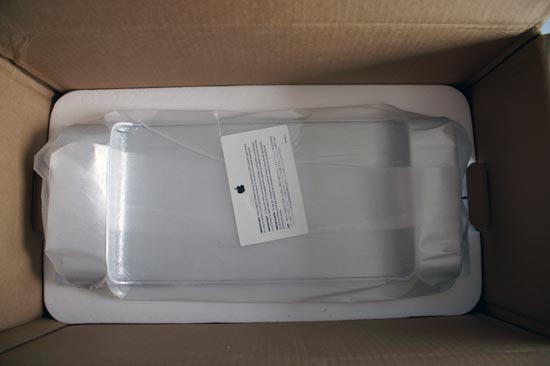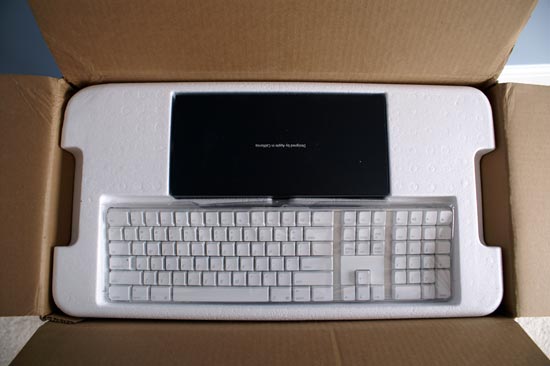Apple's Mac Pro - A True PowerMac Successor
by Anand Lal Shimpi on August 16, 2006 12:27 PM EST- Posted in
- Mac
It's here, it's quiet and it's fast; we got our Mac Pro on Friday and spent every day since taking it apart, using it and benchmarking it. There's far too much to include in one review, so we're breaking it up into three parts. We've already published the first part of our coverage last week, where we discussed the specifications of the new system as well as inadvertently turned the article into a primer on the implications of the FB-DIMMs that the Mac Pro uses. So if you want a brief two-page technical overview of FB-DIMMs, you'll want to consult that article.
Part two is what you're reading today; here we're going to be looking at the Mac Pro as a Mac (mostly) and compare the performance of two speed grades (2.0GHz and 2.66GHz) to the outgoing PowerMac G5. We'll also take the thing apart and give you a nice tour in pictures of the new chassis.

PowerMac G5 (left), Mac Pro box (guess where)
The third and final part will have two focuses - DIY upgrades (e.g. swapping CPUs and sticking in your own FB-DIMMs) as well as performance under Windows XP. Apple just released an updated version of Boot Camp with support for the Mac Pro that should hopefully address some of the serious performance issues we ran into while running Windows XP on our machine. Give us a week and you'll have part 3 to peruse at your leisure.
With our plan of attack laid out, it's time to dive into the Mac Pro and we'll start where very few Mac users like to: at its price. In the past we've generally shied away from getting too caught up in the price debate, because honestly if you're buying a Mac, you're doing so because of the OS and assigning value to that is difficult. Some users are content with other OSes and see no value in OS X, and to them the value in a Mac is simply the total cost of the components that make up the machine. At the same time there are other users who prefer OS X and thus find additional value in a system that is able to run that OS. Regardless of which camp you fall into, the Mac Pro is competitively priced. We'll let the table below do the talking:
|
Apple Mac Pro |
Dell Precision Workstation 490 |
Home Built Config |
|
|
CPU |
2 x Xeon 5150 (2.66GHz) |
2 x Xeon 5150 (2.66GHz) |
|
|
Memory |
2x 512MB DDR2-667 FB-DIMMs |
2x 512MB DDR2-667 FB-DIMMs |
|
|
Graphics |
GeForce 7300 GT |
Quadro NVS 285 |
|
|
Hard Drive |
250GB SATA 3Gbps |
250GB SATA 3Gbps |
|
|
Optical |
SuperDrive (DVD+R DL/DVD+-RW/CD-RW) |
16X DVD+-RW |
|
|
Notes |
Free 17" LCD, had to add sound card, mouse and 1394a card |
Includes Supermicro X7DAE motherboard priced at $474; does not include price of OS, case or power supply |
|
|
Price |
$2499 ($2299 with educational discount) |
$3110 |
$2390 |
The Dell is clearly more expensive, although you can knock off $100 - $200 thanks to the bundled LCD (unfortunately Dell gives you $0 credit if you remove the monitor from your order). We're able to come close with our own configuration by shopping at Newegg and other vendors through our shopping partner, but note that the $2390 total does not include an OS, case or power supply.

If you're in the market for a dual socket dual core Xeon workstation, Apple's Mac Pro is definitely a bargain. The only real issue here is that not everyone needs or can adequately use a dual socket Xeon workstation, in which case you can argue that there's better value in a cheaper single socket Core 2 system. Unfortunately Apple does not offer any such system, which leads us to believe that we'll either eventually see the introduction of a cheaper single socket Mac Pro or maybe even a new product line simply called the "Mac" that uses desktop Core 2 processors instead of their Xeon counterparts.
Bottom line? The default configuration of the Mac Pro is priced very competitively for what you get; whether or not you need what you get is a different discussion entirely.












96 Comments
View All Comments
tmohajir - Thursday, August 17, 2006 - link
I had the same question. I was debating whether to by 2 x 512MB or 1GB, and then thought it might affect performance if I went with the 1GB sticks. I think for now the best bet would be to buy 2 512s so that each branch has a channel with the same amount of memory. Then if I want to upgrade later, move all 4 512s to riser 1, and buy 2 1GB dimms when the price drops a little more and stick them in riser 2. So that way you still have 2GB total per branch.dborod - Thursday, August 17, 2006 - link
I decided to order my MacPro with 4 x 512 MB dimms so as to be able to fully utilize the available memory bandwidth. It seemed the easiest and safest approach for now.dborod - Thursday, August 17, 2006 - link
I decided to order my MacPro with 4 x 512 MB dimms so as to be able to fully utilize the available memory bandwidth. It seemed the easiest and saQuestar - Wednesday, August 16, 2006 - link
Why use MP3 encoding for performace testing in a multi cpu environment? MP3 encoding is not very threadable, and most likely is not threaded to any great extent in iTunes.Griswold - Thursday, August 17, 2006 - link
Somebody obviously has never used the multithreaded encoder of the LAME MT project. I see gains of up to 50% with that. Sure, that may not be relevant for a mac pro user, but it is proof that MP3 encoding benefits from SMT.Questar - Thursday, August 17, 2006 - link
Griswald stikes again.Yes I've heard of LAMEMT. So how's that sound quality you're getting without a bit resevoir? Pretty crappy I'll bet.
Griswold - Friday, August 18, 2006 - link
Oh give me a break nutsack. Dont pretend you know what you're talking about here, as it doesnt match your first (false) post - you obviously never used LameMT. Disabling bit reservoir may come with a certain loss of quality, but its not nearly as much as you (or the poster above) want it to make to be. I'm willing to bet 95% of the people using mp3 wont notice the difference.I'm listening to the same song encoded with standard Lame and LameMT and the quality is virtually the same. Of course, you'll now say your ears are so much better, you got so much better audio equipment and what not.. but meh, it's just questdork talking.
michael2k - Saturday, August 19, 2006 - link
The same 95% of the population who purchase tracks from the iTMS I bet :)Questar - Friday, August 18, 2006 - link
Thanks for the best laugh I've had all week!I really needed it!!
saratoga - Thursday, August 17, 2006 - link
Yeah but you also lose quality, so very few people use it.
Not exactly. LAMEMT is only multithreaded when you use parts of the MP3 standard that can be multithreaded. Typical MP3 encoding as done by lame, itunes, xing, etc simply can not be multithreaded. LAMEMT can be multithreaded because it disables certain features that are incompatable and then implements software pipelining.
The LAME devs have talked about trying to work around this problem in the past, but so far most people seem to think its just not worth the effort because the speed up is much worse then just running two copies of LAME (which gives a 100% speedup verses the 50% you saw), and of course the unresolved questions about just how badly quality would be hurt by rewriting LAME profiles from scratch to use the approach in LAMEMT.